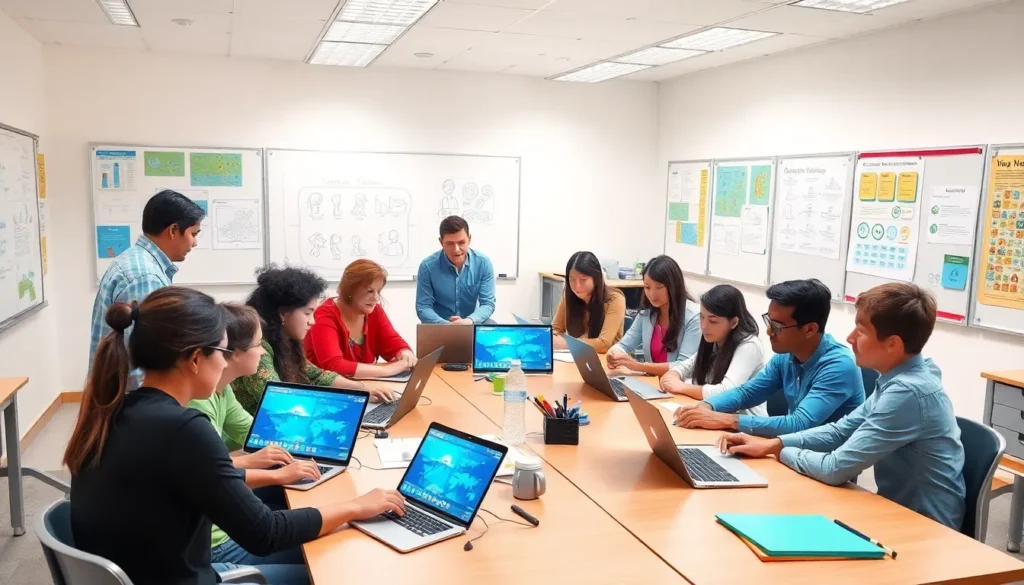Table of Contents
ToggleIn today’s fast-paced world, the classroom is evolving faster than a student can say “pop quiz.” Enter edtech software development, the superhero of education that’s here to save the day. With the right tools, learning can be as engaging as binge-watching a favorite series—minus the cliffhangers, of course.
Overview of Edtech Software Development
Edtech software development represents a crucial aspect of modern education. This sector focuses on creating tools that enhance learning experiences, making education more interactive and accessible. Developers aim to address the needs of various learners, fostering personalized education paths.
Innovative features in these applications include real-time feedback, gamification, and adaptive learning technologies. Such tools allow educators to tailor lessons to individual student requirements, improving engagement and retention rates. Learning management systems (LMS) facilitate the organization and delivery of educational content, streamlining administrative processes.
The rapid advancement of technology is reshaping educational methodologies. Mobile applications offer students flexibility in accessing resources anytime, anywhere. Learning experiences that incorporate virtual reality (VR) and augmented reality (AR) create immersive environments, enhancing comprehension and knowledge retention.
Investors increasingly recognize the potential of edtech. The global edtech market size reached approximately $254 billion in 2020, with projections for substantial growth in the coming years. Regions around the world are prioritizing educational technology as a means to improve learning outcomes and bridge educational gaps.
Collaboration between educators and developers is essential for successful edtech solutions. Feedback from classroom experiences guides the design and functionality of new software tools. Continuous improvement cycles help ensure that these technologies meet evolving educational needs.
Safe and secure platforms are crucial for protecting student data. Adherence to privacy regulations, such as FERPA and COPPA, fosters trust among users. By focusing on security, developers create reliable and responsible educational tools that promote safe learning environments.
Key Components of Edtech Software

Edtech software development includes several key components that enhance educational experiences and foster engagement. Critical features include Learning Management Systems and Assessment Tools.
Learning Management Systems
Learning Management Systems (LMS) streamline the organization and delivery of educational content. These platforms enable educators to manage course materials, track student progress, and facilitate communication. User-friendly interfaces make navigation intuitive for both students and teachers, promoting efficient learning environments. With features like course creation tools, multimedia integration, and real-time tracking, LMSs help educators customize learning experiences based on individual student needs. Analytics within these systems provides valuable insights into student performance, allowing for data-driven adjustments to teaching strategies.
Assessment Tools
Assessment tools play a vital role in evaluating student understanding and progress. These tools offer various methods, including quizzes, assignments, and interactive evaluations. Immediate feedback capabilities help students identify strengths and areas for improvement, promoting a growth mindset. Customizable assessments allow educators to align evaluation methods with curriculum goals. Integration with LMS enhances the overall educational experience by consolidating performance data in one location. Additionally, these tools facilitate adaptive learning by adjusting difficulty levels based on student responses, ensuring personalized learning paths for each student.
The Development Process
The development of edtech software involves several critical stages. Each phase plays a vital role in ensuring the final product meets educational needs and engages students effectively.
Research and Planning
Effective research defines the foundation of any successful edtech project. Professionals conduct market analyses to identify gaps in current offerings, emphasizing user needs and preferences. Gathering feedback from educators ensures the development aligns with classroom realities. This stage also encompasses the creation of a project roadmap, detailing necessary features and functionality for enhanced usability. Prioritizing these requirements facilitates goal-oriented development, ultimately accelerating time-to-market for the application.
Design and Prototyping
Designing intuitive interfaces stands central to a positive user experience. The use of wireframes allows designers to visualize the application layout, ensuring clarity in user navigation. At this point, prototyping provides a tangible representation of the software, enabling stakeholders to assess functionality and aesthetics. Iterative feedback from potential users fosters continuous improvement, refining the design according to real-world requirements. Engaging users during this phase bolsters user satisfaction, increasing the likelihood of successful adoption in educational settings.
Development and Testing
Once designs are finalized, developers commence coding the application, focusing on scalability and performance. Agile methodology often drives this process, allowing for flexibility in iteration. Thorough testing of the software is crucial at this stage, identifying bugs and usability issues before launch. Quality assurance ensures the application adheres to educational standards and guidelines. A well-tested solution promotes a seamless user experience, reducing the likelihood of disruptions during actual classroom use. Prioritization of user feedback drives improvements, enhancing overall educational impact.
Trends in Edtech Software Development
Edtech software development is rapidly evolving, adapting to new technologies and educational needs. Current trends focus on AI and mobile learning solutions to enhance the educational experience.
AI and Personalization
AI technology plays a critical role in personalizing learning experiences. By analyzing student data, AI algorithms can tailor educational content to suit individual learning styles and preferences. This adaptation ensures students receive the support necessary for effective learning. Furthermore, real-time feedback powered by AI enables educators to track progress and adjust teaching strategies promptly. Institutions adopting AI-driven systems experience enhanced engagement and improved academic outcomes.
Mobile Learning Solutions
Mobile learning solutions are reshaping how students access educational materials. Apps designed for smartphones and tablets offer flexibility, allowing learners to study anytime, anywhere. Many of these solutions incorporate gamified content to make learning more interactive and enjoyable. Mobile platforms also support offline access, ensuring continuous learning regardless of internet availability. Analyst reports point to a significant increase in mobile learning adoption among students seeking a seamless educational experience. As mobile technologies advance, these solutions will become increasingly integral to the learning process.
Challenges in Edtech Software Development
Edtech software development encounters various challenges that can hinder progress. One major issue involves integrating advanced technologies while accommodating diverse user needs. Developers must balance creating innovative features with ensuring usability for students and educators.
Data security stands as another prominent challenge. Protecting sensitive student information is crucial, making compliance with privacy regulations essential for trust in educational tools. It demands ongoing vigilance and investment in robust security measures.
Ensure seamless interoperability between different systems also presents difficulties. Many schools use multiple platforms, and developers must create solutions that work well together to enhance user experience.
Limited funding sources can restrict project scope. Developers often rely on grants or partnerships for financial support, which may not always align with their vision or timelines. They face pressure to deliver valuable features quickly, which can compromise thorough testing.
User feedback drives enhancements but can be challenging to incorporate effectively. Developers must engage with educators to gather insights and implement changes while managing project timelines. Active collaboration fosters the creation of impactful tools tailored to real-world classroom needs.
Scalability poses additional concerns as edtech tools must accommodate varying numbers of users without performance degradation. Developers should plan for future growth from the onset to avoid overhauls.
Cultural differences in educational practices around the globe require adaptability in software solutions. Developers must recognize and design for these variances to ensure worldwide applicability and acceptance.
Navigating these challenges involves a proactive approach to understanding user needs, ensuring security, and maintaining flexibility in design and implementation.
Edtech software development is reshaping the educational landscape by creating innovative tools that enhance learning experiences. As technology continues to advance, the collaboration between educators and developers becomes increasingly vital. This partnership ensures that the solutions developed meet the diverse needs of students while adhering to security and privacy standards.
The integration of AI and mobile solutions is paving the way for personalized and flexible learning environments. By addressing challenges such as data security and scalability, the edtech industry can foster a more effective and engaging educational experience. As the global market for educational technology grows, its potential to transform classrooms and improve learning outcomes is undeniable.







